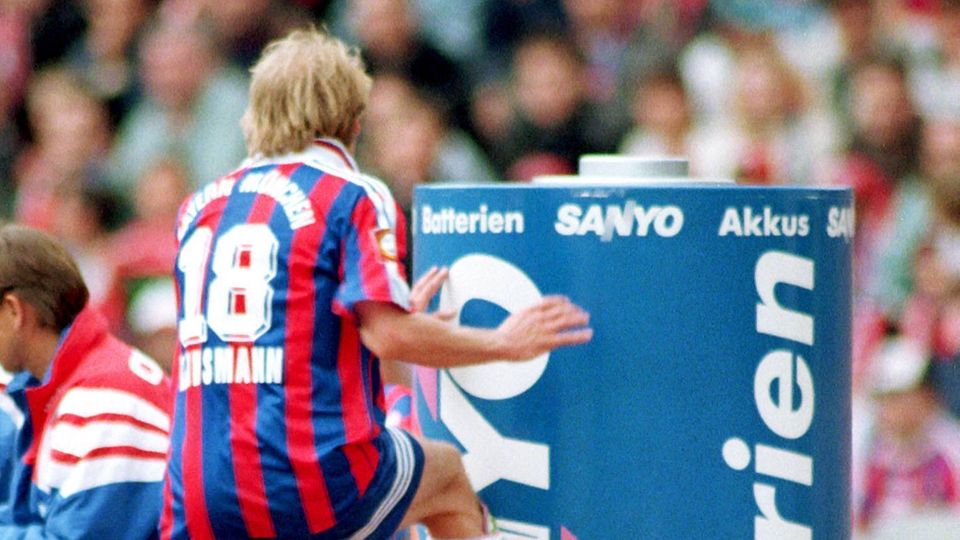New Bayern documentary
“Lothar, what are you wearing underneath?”
Things were wild and unbridled at FC Bayern in the 1990s. The ZDF documentary “FC Hollywood” tells the story of these times – with Lothar Matthäus as the tragic hero at the center.
The series about FC Bayern has five parts and lasts more than three hours, but there is one scene, less than ten seconds long, in which the whole work is condensed.
Lothar Matthäus stands in a clothing store in Munich, a men’s outfitter, as they said back in the 90s, and looks at shirts and pants. A saleswoman comes up to him, holding red boxer shorts in her hand. “Lothar, what are you wearing underneath?” she asks. Matthew collects himself briefly and answers: “I have to be honest: I used to wear boxer shorts, but now I’m more into less material again.”
I’m now more into less material again. A sentence for eternity, and at the same time so indicative of the decade in which FC Bayern was much more than a football club. A kind of newsroom that produced daily headlines for the tabloids: stories about intimacy and affairs, reports about rifts and discord in the team, about drinking, drunk driving and riots, about powerless coaches and outraged club bosses who – now for good! – want to ensure peace and quiet but can’t manage it.
The primal conflict: Lothar Matthäus versus Jürgen Klinsmann
During the phase that began in 1995, the club was renamed “FC Hollywood” by the newspapers, supposedly an idea from then-Bunte editor-in-chief Patricia Riekel. At least in the beginning, the club wore the nickname with some pride. Finally more attention again, the whole of Munich was talking about FC Bayern. That’s what manager Uli Hoeneß wanted, because the Olympic Stadium was often only half full when the team played.
This dissolution of boundaries, the abolition of privacy at Germany’s largest football club, is the subject of a ZDF documentary. It’s called “FC Hollywood”, the title was obvious, and it strings one schmo after the next, in quick cuts, sometimes breathlessly. There is also a lot to tell.
There is the primal conflict, the dispute between Lothar Matthäus and Jürgen Klinsmann, who couldn’t stand each other at Inter Milan and who were supposed to lead FC Bayern to an international title from 1995 onwards. Together.
Matthew senses a big plot
Matthäus sees Klinsmann as a competitor who threatens to take away the light in which he himself likes to stand. Matthäus also believes that Klinsmann bad-mouthed him to national coach Berti Vogts and forced him out of the national team. Matthäus senses a big plot and even challenges Klinsmann and Vogts to a TV duel (“the truth has to be on the table!”).
Matthäus and Klinsmann, that couldn’t go well, that was the verdict of many people involved at the time. Thomas Helmer, Mehmet Scholl, Stefan Effenberg, Mario Basler, Klinsmann and Matthäus – director Nicolas Berse-Gilles got some of the former Bayern grandees in front of the camera and asked them about the wild 90s. The result is less a portrait of a team than a piece about media changes in football.
Anyone who hears the stories from back then can hardly believe that they only happened 30 years ago. From today’s perspective, FC Bayern was in the Middle Ages when it came to its media work. Markus Hörwick, the club’s press officer from 1983 to 2016, still seems exhausted today when he talks about his job: “Basler, Effenberg, Scholl and Matthäus. That’s just before the insane asylum.”
Hörwick never got his people under control. Most of the so-called stars had their own channels through which they made politics, although Hörwick and Hoeneß repeatedly begged them not to broadcast anything to the outside world.
FC Hollywood: Every star had their own channel
Lothar Matthäus’ broadcaster was the “Bild” newspaper. Matthäus had a particularly close relationship with their reporter Wolfgang Ruiner, nickname Blunzi. He visited Ruiner at home, they ate and drank together, played backgammon, no one was closer to Bayern’s captain than Blunzi.
For “Bild”, Ruiner was worth his weight in gold because he could write about team meetings as if he himself had been sitting in the Bayern dressing room. This caused quite a stir in the club, Matthäus was considered a mole and from then on had a difficult time in the team.
No problem for Matthew. He trusted Ruiner, who had long since become an advisor to him. Ruiner is also the one who convinces Matthäus to publish a book about the inner workings of FC Bayern, a so-called diary. In it, Matthew reports frankly who stands by whom and how; Matthäus also informs his readers about health topics such as Thomas Helmer’s stomach and gallbladder problems.
This book was one breach of trust too many. Matthäus was removed as Bayern captain, and Blunzi from the “Bild” newspaper could no longer help. About his relationship with Ruiner, Matthäus says in the documentary: “You think he’s a friend, but in the end, of course, he just looked at his headlines. It would have been better if I hadn’t gotten to know him.”
A media satire as written by Helmut Dietl
The story of Matthäus and Ruiner seems like it was written by Helmut Dietl for “Kir Royal”, so otherworldly, so satirically exaggerated. But no, that was the 90s at FC Bayern. And how ridiculous it seems when today people still write about “FC Hollywood” whenever there is some unrest in the club. The expulsion of Julian Nagelsmann, the unfortunate Thomas Tuchel era, the long search for a new coach – the picture of a club in chaos was always painted and was reminiscent of the 90s. Even if the Matthäus generation never won the Champions League title they longed for and often disappointed in other ways: the title “FC Hollywood”, as this tasty documentary shows, belongs only to them.
The documentary series “FC Hollywood. FC Bayern and the crazy 90s” will be available in the ZDF media library from January 10th. It will be shown on linear TV (ZDF) on January 17th at 10:30 p.m.
Source: Stern
I am Pierce Boyd, a driven and ambitious professional working in the news industry. I have been writing for 24 Hours Worlds for over five years, specializing in sports section coverage. During my tenure at the publication, I have built an impressive portfolio of articles that has earned me a reputation as an experienced journalist and content creator.






